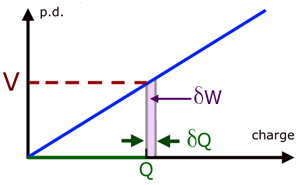- A capacitor can store energy, so capacitors are often found in power supplies.
-
What happens when a capacitor is charging and discharging?
Charging As soon as the
switch is closed in position 1 the battery is connected across the capacitor, current flows and
the potential difference across the capacitor begins to rise but, as more and more charge
builds up on the capacitor plates, the current and the rate of rise of potential difference both
fall. (See Figure 3). Finally no further current will flow when the p.d. across the capacitor
equals that of the supply voltage Vo.
As soon as the
switch is closed in position 1 the battery is connected across the capacitor, current flows and
the potential difference across the capacitor begins to rise but, as more and more charge
builds up on the capacitor plates, the current and the rate of rise of potential difference both
fall. (See Figure 3). Finally no further current will flow when the p.d. across the capacitor
equals that of the supply voltage Vo.
The capacitor is then fully charged.
Discharging
As soon as the switch is put in position 2 a 'large' current starts to flow and the potential difference across the capacitor drops. (Figure 4). As charge flows from one plate to the other through the resistor the charge is neutralised and so the current falls and the rate of decrease of potential difference also falls.
Eventually the charge on the plates is zero and the current and potential difference are also zero - the capacitor is fully discharged. Note that the value of the resistor does not affect the final potential difference across the capacitor – only the time that it takes to reach that value.
The bigger the resistor the longer the time taken.me taken. -
Define 1 Farad
I farad is the capacitance of a capacitor if it stores a charge of 1Coulomb when the potential differencebetween the plates is 1 volt

Capacitor stores energy in the electric field between the plates.
Let Q be the charge stored in a capacitor when the potential difference is V.
The graph between Q and V is a straight line.

When the capacitor is discharging it is releasing energy.When it loses a small charge ∆Q ,it releases ∆Q a small amount of energy ,∆W.
∆W =∆Q X V = Area of the small strip on graph.When the capacitor discharges fully, V and Q drop to zero and all the energy is released.
The energy released = total area under the graph.
Energy=1/2 QV= 1/2 C V2
Q) Calculate the effective resistance
Q) Calculate the total energy stored in the capacitors














No comments:
Post a Comment